State funeral
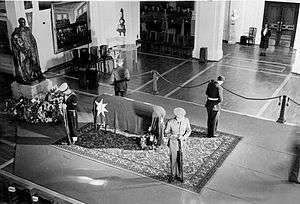
A state funeral is a public funeral ceremony, observing the strict rules of protocol, held to honour people of national significance. State funerals usually include much pomp and ceremony as well as religious overtones and distinctive elements of military tradition. Generally, state funerals are held in order to involve the general public in a national day of mourning after the family of the deceased gives consent. A state funeral will often generate mass publicity from both national and global media outlets.
Africa
Ethiopia
Gabon
Ghana
Malawi
South Africa
Tanzania
Zambia
Americas
Argentina

In 1952 Eva Perón died at age 33. She had the title of Spiritual Leader of the Nation of Argentina, a title granted by the Congress of Argentina. Nearly three million people covered the funeral of Evita in the streets of Buenos Aires. A radio broadcast interrupted the broadcasting schedule, with the announcer reading, "The Press Secretary's Office of the Presidency of the Nation fulfills its very sad duty to inform the people of the Republic that at 20:25 hours Mrs. Eva Perón, Spiritual Leader of the Nation, died." Eva Perón was granted a state funeral and a full Roman Catholic requiem mass.[1] On 9 August, Saturday, the body was then transferred to the Congress Building for an additional day to be publicly viewed. On Sunday, 10 August, after a final Sunday mass, the coffin was laid atop on a gun carriage pulled by CGT officials. Following next was Juan Perón, his cabinet, Eva's family and friends, the delegates and representatives of the Partido Peronista Femenino, then workers, nurses and students of the Eva Perón Foundation. Passing her coffin through the streets was showered with carnations, orchids, chrysanthemums, wallflowers and roses thrown from the balconies nearby.
Juan Perón died at age 78 on July 1, 1974, after his health would be aggravated. The Vice President, saying the country was announced "with great sorrow I must convey to the people of Argentina the death of this true apostle of peace and nonviolence." After several days of national mourning, in which the body lay in state at the Argentine National Congress for hundreds of thousands of people, the remains were moved to a crypt in the Quinta de Olivos Presidential. On November 17, 1974 the remains of Evita. While the body was in Congress, filed past the coffin 135,000 people, out of more than a million Argentines lost their bid farewell to their leader. Two thousand foreign journalists reported the details of the funeral.
Raul Alfonsín died at age 82 on 31 March 2009, due to lung cancer and then his health would be aggravated, in his last days, broncoaspirativa pneumonia. Argentina's government declared three days of national mourning for the death and his remains were veiled from the early hours of April 1, 2009 in the Blue Room of the National Congress, which was attended also by authorities and politicians of different parties an estimated 80,000 people had to wait in line for five to six hours. Among the political authorities who attended the event were former presidents Carlos Menem, Eduardo Duhalde, Fernando De la Rua and Nestor Kirchner, President Cristina Fernandez was unable to attend because they were in the G-20 London but sent its condolences. The next day they were taken to a military gun carriage escorted by the Mounted Grenadiers Regiment at Recoleta Cemetery in Buenos Aires. The remains of former President rested temporarily in the vault of the fallen in the Revolution of the Park until 16 May were transferred to a single monument in the cemetery in a place built of gray and beige marble, where there is a cross on top and a bright stained glass by entering a glimmer.
Argentina's former President and Secretary General of UNASUR, Néstor Kirchner, died of heart failure on the morning of 27 October 2010 at the Jose Formenti hospital in El Calafate, Santa Cruz Province at the age of 60.[2] Although there was some effort made to revive him, it did not do so[3] His wife, President Cristina Fernández de Kirchner, was present with him when he died.[4] He was also expected to run for president in 2011.[5]
Barbados
A state funeral was held on November 3, 2010 in Bridgetown for former Barbados Prime Minister David Thompson.[6]
Brazil

State funerals were held for the president-elect of Brazil, Tancredo Neves, who died before taking office. The former vice-president of Brazil, José Alencar, was also buried with a head of state's honor, after his passing due to cancer. Other than heads of state, personalities such as the Formula 1 racing champion Ayrton Senna, dead in 1994 after a crash during a race, and the architect Oscar Niemeyer, who died in 2012 at the age of 104.
Canada
In Canada, state funerals are public events held to commemorate the memory of present and former governors general, present and former prime ministers, sitting members of the Ministry (the Privy Council) and other prominent Canadians at the discretion of the Prime Minister. With ceremonial, military, and religious elements incorporated, state funerals are offered and executed by the Government of Canada which provides a dignified manner for the Canadian people to mourn a national public figure.
In 2006, the House of Commons voted unanimously, on a motion introduced by the NDP, to hold a state funeral when the last Canadian veteran of the First World War died. However, John Babcock, after becoming the last surviving veteran, stated that he did not feel the need to be honoured in such a way.
In August 2011, in a rare circumstance, Prime Minister Stephen Harper offered a state funeral for his political adversary and Leader of the Opposition, Jack Layton. Layton died of cancer three months after his New Democratic Party became the official opposition, for the first time in his party's history.
In 2014, former finance minister Jim Flaherty received a state funeral after his death.
Dominica
Crispin Sorhaindo, former President of Dominica, was given a state funeral on January 18, 2010 in Roseau.[7]
Ecuador
On November 16, 2016, the state funeral of former President of Ecuador Sixto Durán Ballén was held in Quito.[8]
Grenada
On March 16, 2012, a state funeral was held in St. George's for former Grenadian Prime Minister George Ignatius Brizan.[9]
Jamaica
Legendary reggae singer Bob Marley received a state funeral in Jamaica on 21 May 1981, which combined elements of Ethiopian Orthodoxy[10][11] and Rastafari tradition.[12]
On July 18, 2004, a state funeral was held for former Jamaican Prime Minister Hugh Shearer in Kingston.[13]
Mexico
Novelist Carlos Fuentes received a state funeral on May 16, 2012, with his funeral cortege briefly stopping traffic in Mexico City. The ceremony was held in the Palacio de Bellas Artes and was attended by President Felipe Calderón.[14]
State funerals have also been held for former Mexican presidents. Traditionally, the final funeral services for a former Mexican president is held at either the Mexico City Metropolitan Cathedral or Basilica of Our Lady of Guadalupe. The services are attended by the former president's family, the current President of Mexico, the Head of Government of the Federal District and their families, foreign heads of state or their representatives (usually a foreign ambassador, vice president, prime minister or premier), military officials, Senators and Deputies, and other dignitaries. The principal celebrant of the service is usually the Archbishop of Mexico City, and traditionally the President and the Head of Government of the Federal District deliver the final eulogies and remarks.
On the days leading to a Presidential state funeral, the Mexican flags are at half-mast, and the Olympic cauldron at Estadio Olimpico Universitario is lit until the funeral services have ended. The day of the Presidential funeral, if held in Mexico City, is usually the national day of mourning; there is no mail to be delivered on that day, all schools and colleges in Mexico City are closed, and all television and motion picture studios in Mexico City, and with them the studios of Televisa and TV Azteca affiliates across Mexico, are closed to audiences and tours. All business, including shopping centers and entertainment facilities, in Mexico City are closed; stores and theaters that are part of regional and national chains headquartered in Mexico City are closed.
The most recent Presidential funeral was that of Miguel de la Madrid, which was attended by thousands of dignitaries including President Calderon and Head of Government of the Federal District Marcelo Ebrard.
St Lucia
Sir William George Mallet GCSL GCMG CBE (July 24, 1923 – October 20, 2010) received a State Funeral on October 28, 2010 in the capital Castries. Mallet was a politician who held a number of high offices in Saint Lucia, one of the Windward Islands of the Lesser Antilles in the Eastern Caribbean. On June 1, 1996, "Sir George" was appointed to the office of Governor General of St Lucia.
The Bahamas
On September 4, 2000, a state funeral was held in Nassau for former Bahamian Prime Minister Sir Lynden Pindling.[15] On January 5, 2012, a state funeral was held in Nassau for former Bahamian Governor-General Sir Clifford Darling.[16]
United States
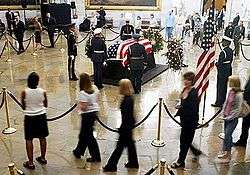
In the United States, state funerals are held in the nation's capital, Washington, D.C., and involve military spectacle, ceremonial pomp, and religious observance. As the highest possible honor bestowed upon a person posthumously, state funerals are an entitlement offered to a sitting or ex-President of the United States, a President-elect, as well as other people designated by the President.[17][18] Administered by the Military District of Washington (MDW), state funerals are greatly influenced by protocol, steeped in tradition, and rich in history. However, the overall planning as well as the decision to hold a state funeral, is largely determined by the President before his death and the First Family.[19]
State funerals have been held in Washington D.C. for William Henry Harrison (1841),[20] Zachary Taylor (1850),[20] Abraham Lincoln (1865),[21] Thaddeus Stevens (1868),[22] James A. Garfield (1881),[20] William McKinley (1901),[20] Warren Harding (1920),[20] the Unknown Soldier of World War I (1921),[23] William Howard Taft (1930),[24] John J. Pershing (1948),[25] the Unknown Soldiers of World War II and the Korean War (1958),[26] John F. Kennedy (1963),[27] Douglas MacArthur (1964),[28] Herbert Hoover (1964),[29] Dwight D. Eisenhower (1969),[30] Lyndon B. Johnson (1973),[31] Ronald Reagan (2004),[32] and Gerald Ford (2006-2007).[33]
Asia/Pacific
Australia
In Australia, Commonwealth (federal) state funerals are generally offered to former governors-general, prime ministers and long-serving members of the Parliament of Australia. In rare occasions a Commonwealth state funeral is offered to people outside politics but who made a significant contribution to the nation, for example Sir Douglas Mawson was granted a Commonwealth state funeral in 1958, as was AFL footballer Jim Stynes in 2012.[34] A Commonwealth state funeral was offered for Margaret Whitlam but the Whitlam family declined.[35]
Military state funerals are offered to former senior officers of the Australian Defence Force, for example Field Marshal Sir Thomas Blamey, and sometimes given to governors-general, prime ministers, state governors and state premiers who had previous military service. The Unknown Soldier was given a Commonwealth military state funeral on 11 November 1993 before being interned in the Hall of Memory at the Australian War Memorial. In the early years of the 21st century, military state funerals were offered to the last few World War I veterans.
New South Wales
State funerals held in NSW are subject to a policy operated since 1966. Governors, Chief Justices, premiers, and long-term ministers are generally offered a state funeral. However the premier of NSW can offer such a service for those determined to be distinguished citizens of NSW. For example, soccer player Johnny Warren was given a state funeral in NSW. Where the family of the dead person does not wish to have a state funeral, the offer of a state memorial service will be considered.
Some former governors who had previous military service were given military state funerals, for example Rear Admiral Sir David Martin and Air Marshal Sir James Rowland.
On 27 November 2007, Bernie Banton, a campaigner for asbestos victims who worked for James Hardie, lost his battle with mesothelioma, an asbestos-related disease. His family was offered a state funeral by NSW premier Morris Iemma.
Queensland
Current and former Governors, Premiers, deputy premiers, speakers of the Legislative Assembly, chief justices of the Supreme Court, presidents of the Court of Appeal and current members of the members of the Executive Council are automatically eligible for a state funeral.[36] It is the prerogative of the premier of the day to offer a state funeral to other prominent Queenslanders. A state funeral was offered for TV celebrity Steve Irwin in September 2006 but his family declined the offer.
Victoria
State funerals are generally offered to former governors, premiers and other senior public officials. At the discretion of the premier, a state funeral can be offered to other prominent Victorians, for example broadcaster Peter Evans (1985), Australian Rules football player Ted Whitten (1995), race-car driver Peter Brock (2006), actor Charles 'Bud' Tingwell (2009), and former Australian Rules football player and charity worker Jim Stynes (2012).[37] Explorers Robert O'Hara Burke and William John Wills received Victoria's first (and Australia's first) state funeral on 21 January 1863.[38]
South Australia
State funerals are generally offered to former Governors, Premiers, Deputy Premiers, Speakers of the House of Assembly, Chief Justices and other senior public officials.
Western Australia
The offer of a state funeral is a decision of the Cabinet.
Tasmania
State funerals are generally offered to former Governors, Premiers, Deputy Premiers, Speakers of the House of Assembly, Chief Justices and other senior public officials.
Australian Capital Territory
The offer of a state funeral is at the discretion of the Chief Minister. People who have received state funerals include former chief minister Trevor Kaine, Supreme Court judge Terry Connolly and former chairman of the Canberra Commercial Development Authority Jim Pead.
Cambodia
Cambodia held state funerals for the following people:
- King Norodom Suramarit (1960)
- King Norodom Sihanouk (2012)
Republic of China
According to the Act of State Funeral (1948), state funerals are declared by presidential order after a majority vote in the Legislative Yuan. The national flag shall be flown at half-mast on the day of the state funeral.
State funerals (or equivalent) were arranged for the following persons:
- By the Parliament of the Republic of China
- Cai E (1917)
- Huang Xing (15 April 1917)
- Sun Yat-sen (1 June 1929)
- By the Canton Military Government
- Cheng Biguang (2 March 1918)
- Li Zhonglin (1920)
- Lin Xiumei (1921)
- Wu Tingfang (3 December 1924)
- Liao Zhongkai (August 1925, 1935)
- By the Nanking Nationalist Government
- Tan Yankai (1930)
- Lu Shidi (1930)
- Li Yuanhong (1925)
- Duan Qirui (2 November 1936)
- Hu Hanmin (17 June 1936)
- Shao Yuanchong (9 March 1937)
- Zhu Peide (13 March 1937)
- Tang Jiyao (25 December 1937)
- Liu Xiang (14 February 1938)
- Xie Chi (6 May 1939)
- Lin Sen (August 1943)
- Cai Yuanpei (10 May 1947)
- Zhang Zizhong (28 May 1940)
- Tong Linge (28 July 1946)
- Bo Wenwei, Chen Qimei, Zhang Ji, Hao Mengling, Li Jiayu, Qin Zhen (19 May 1948)
- Tai Chi-tao (April 1949)
- By the Government of Republic of China
- Chen Cheng (1965)
- Chiang Kai-shek (1975)
- Chiang Ching-kuo (1988)
- Yen Chia-kan (22 January 1994)
- Teresa Teng (28 May 1995)
- 8 soldiers who died in the UH-1 tragedy (11 April 2007)
Hong Kong
British Hong Kong
Prior to 1997, in British Hong Kong, Edward Youde was given Hong Kong's first state funeral in 1986.[39] The casket was carried by ten guardsmen, draped in the Union Flag,[40] and a 17-gun salute from HMS Tamar (shore station) was fired. The funeral was exceptionally well attended.
Hong Kong post-1997
Since 1997, only three people from Hong Kong have been allowed to have the flag of the People's Republic of China draped on their coffin during their funeral:
- Henry Fok Ying-tung (2006)—Beijing and Hong Kong; Hong Kong businessman
- Mr. Ann Tse-kai (2000)—Hong Kong - former Legislative Council, Executive Council of Hong Kong, Chinese People's Political Consultative Conference, Basic Law Committee, Hong Kong Affairs Advisor
- Wong Ker-lee (2004) - Hong Kong business man, founder of Winco Paper Products
Funerals using a SAR flag are not deemed state funerals in Hong Kong.
Uniform services also provide funerals for fallen members. Flags of the specific service or the SAR flag maybe used on the coffin. Escort maybe provided by Hong Kong Police to Gallant Garden. For police funerals the force's pipe band, police vehicles (to transport the body) and pallbearers are used.
India
In India, State funerals were initially reserved only for current and former Presidents, Prime Ministers, Union ministers and State Chief Ministers. And the decision to accord a state funeral rested initially with the union government. But laws have been changed such that the state government can now decide who will be given a state funeral, depending on the stature of the deceased. If the union government has decided for a state funeral then following procedures will be applied to all over India, else if the state government has declared a state funeral then it applies only to the state.
The government takes into consideration the contribution made by the person to the state in various fields like politics, literature, law, science and arts. The chief minister of the concerned state takes a decision after consultations with other cabinet ministers. Once a decision is taken on the issue, it is conveyed to senior police officials including the deputy commissioner, the police commissioner and the superintendent of police, who have to make all the arrangements for a state funeral.
During a State funeral,
- A state mourning or National day of mourning is officially declared.
- The national flag is flown at half mast as per the Flag Code of India. This decision solely lies with the President of India, who also decides the period for which flag is to be flown at half mast.
- A public holiday is declared.
- The deceased person's bier or coffin is draped with the national flag with saffron towards the head of the bier or coffin while lying in state. The flag should not be lowered into the grave or burnt in the pyre.
- He/She is honored with a gun salute when being buried or cremated.
State funerals were organized for the following India's Prime Ministers who died in office:
- Jawaharlal Nehru (1964)
- Lal Bahadur Shastri (1966)
- Indira Gandhi (1984)
- Rajeev Gandhi (1991)
Personalities who received a state funeral who were not current or former Presidents, Prime Ministers or Union Ministers are:
- Mahatma Gandhi - (1948)
- Mother Teresa - (1997)
- Gangubai Hangal (2009)
- Jyoti Basu - (2010)
- Bhimsen Joshi - (2011)
- Bal Thackeray - (2012).[41]
- Sarabjeet Singh (2013)[42]
- E. K. Mawlong (2008)
It is also to be noted that in the event of death of either the Head of the State or Head of the Government of a foreign country the Indian Mission accredited to that country may fly the national flag at half-mast. In the case of Pope John Paul II, India declared a three-day official mourning period.
Indonesia
A state funeral was arranged for the military ceremony on their deathbed on the respective date:
- Sudirman (30 January 1950)
- Heroes of the Revolution, assassinated during 30 September Coup Attempt (5 October 1965)
- Sukarno (22 June 1970)
- Mohammad Hatta (15 March 1980)
- Hamengkubuwono IX (8 October 1988)
- Tien Suharto (29 April 1996)
- Suharto (28 January 2008)
- Abdurrahman Wahid (31 December 2009)
Iran
- Hassan-Ali Mansur (27 January 1965)
- Mohammad Ali Rajai and Mohammad Javad Bahonar (30 August 1981)
- Ruhollah Khomeini (5 June 1989) - funeral attracted over 3 million people.
Japan
In Japan, before the Second World War, a state funeral was performed when an Imperial edict is issued. Since then, funerals of the Emperor and the other members of the Imperial Family were privately organized, and only certain portions of the funeral involved the state.
Formal state funeral
- Iwakura Tomomi (1883)
- Shimazu Hisamitsu (1887)
- Sanjō Sanetomi (1891)
- Prince Arisugawa Taruhito (1895)
- Prince Kitashirakawa Yoshihisa (1895)
- Mouri Motoniri (1896)
- Shimazu Tadayoshi (2nd) (1898)
- Prince Komatsu Akihito (1903)
- Itō Hirobumi (1909)
- Emperor Meiji (1912)
- Prince Arisugawa Takehito (1913)
- Ōyama Iwao (1916)
- Gojong of Korea (1919)
- Yamagata Aritomo (1922)
- Prince Fushimi Sadanaru (1923)
- Matsukata Masayoshi (1924)
- Sunjong of Korea (1926)
- Emperor Taishō (1926)
- Tōgō Heihachirō (1934)
- Saionji Kinmochi (1940)
- Isoroku Yamamoto (1943)
- Prince Kan'in Kotohito (1945)
- Shigeru Yoshida (1967)
Funeral where the state is involved
- Ōkuma Shigenobu (1922)
- Kijūrō Shidehara (1951)
- Eisaku Satō (1975)
- Masayoshi Ōhira (1980)
- Nobusuke Kishi (1987)
- Takeo Miki (1988)
- Emperor Shōwa (1989)
- Takeo Fukuda (1995)
- Keizō Obuchi (2000)
- Ryutaro Hashimoto (2006)
- Kiichi Miyazawa (2007)
New Zealand

Traditionally, state funerals are reserved for all former Governors-General, as well as Prime Ministers who die in office, such as John Ballance in 1893, Joseph Ward in 1930[43] and Michael Joseph Savage in 1940.[44] The funeral of John Ballance occurred in Whanganui after a lying in state in the New Zealand Parliament and a rail journey from Wellington. It was a Masonic funeral carried out at the Whanganui cemetery where he was interred.[45] Both funerals of Ward and Savage were held in Sacred Heart Cathedral adjacent to the New Zealand Parliament.[44] In the case of Savage, his body lay in state in the Parliament building, where 50,000 people filed past it, before the Requiem Mass at the Cathedral.[44] Others to receive state funerals include Sir Frederic Truby King (1937) who founded the Plunket Society, the unidentified victims of the Tangiwai rail disaster (1953),[46] Victoria Cross recipient Jack Hinton (1997),[47] the mountaineer Sir Edmund Hillary (2008)[48] and the Unknown Warrior whose reinterment (from the Caterpillar Valley Cemetery on the Somme in France) took place on Armistice Day, 11 November 2004 and whose tomb at the New Zealand National War Memorial represents all New Zealand soldiers who died in war.[49] The offer of a state funeral was refused by the family of former Prime Minister David Lange.[50]
Philippines
The Philippines held state funerals for the following people:
- Manuel L. Quezon (1946) - 2nd President of the Philippines (1935–44): died in office[51]
- Manuel Roxas (1948) - 5th President of the Philippines (1946–48): died in office[51]
- Elpidio Quirino (1956) - 6th President of the Philippines (1948–53)[51]
- Ramon Magsaysay (1957) - 7th President of the Philippines (1953–57): died in office[51]
- Sergio Osmeña (1961) - 4th President of the Philippines (1944–46)[51]
- Emilio Aguinaldo (1964) - 1st President of the Philippines (1899–1901)[52]
- Carlos P. Garcia (1971) - 8th President of the Philippines (1957–61)[51]
- Carlos P. Romulo (1985) - Secretary of Foreign Affairs (1968–84)[53]
- Diosdado Macapagal (1997) - 9th President of the Philippines (1961–65)[54]
- Blas Ople (2003) - Secretary of Foreign Affairs (2002–03): died in office[53]
- Perla Dizon Santos-Ocampo (2012) - National Scientist of the Philippines[55]
- Jesse Robredo (2012) - Secretary of Interior and Local Government (2010–12): died in office[56]
Singapore
A state funeral was arranged for the following people on their deathbed on the respective date:
- Yusof bin Ishak (23 November 1970) - 1st President of Singapore
- Benjamin Henry Sheares (12 May 1981) - 2nd President of Singapore
- Wee Kim Wee (2 May 2005) - 4th President of Singapore
- S. Rajaratnam (25 February 2006) - former Deputy Prime Minister of Singapore
- Goh Keng Swee (23 May 2010) - former Deputy Prime Minister of Singapore
- Kwa Geok Choo (2 October 2010) - spouse of Lee Kuan Yew
- Lee Kuan Yew (23 March 2015) - 1st Prime Minister of Singapore
- S. R. Nathan (22 August 2016) - 6th President of Singapore
Another type of funeral in Singapore is a state-assisted funeral. Similar to a state funeral, the deceased may or may not be entitled to a ceremonial gun carriage, though he/she does not lie in state in the Istana. Such funerals are accorded to:
- Ong Teng Cheong (11 February 2002) - 5th President of Singapore
- Lim Kim San (20 July 2006) - former Deputy Prime Minister
- Toh Chin Chye (7 February 2012) - former Deputy Prime Minister
South Korea
- Park Chung-hee (1979)
- Kim Dae-jung (2009)
- Kim Young-sam (2015)
Thailand
See also: Buddhist funeral and Antyesti for more information
State funerals in Thailand are a mix of the Buddhist and Hindu traditions. Generally, state funerals for lay Buddhists who served in the government, the armed forces and the police and the Buddhist clergy, as well as for members and relatives of the Royal Family of Thailand (as may be granted by the government) start with the traditional bathing of the body of the decreased and then putting it in gold funeral urns or phra kot (as was the case during the state funeral for HRH Princess Bejaratana Rajasuda and in the tradition of former kings of Thailand and deceased members of the royal family) or, as in the cases of HRH Srinagarindra, the Princess Mother, HRH Galyani Vadhana, the Princess of Naradhiwas, and HM King Bhumibol Adulyadej (Rama IX), gold coffins in the manner of Western royals, heads of state and members of the government, the military and police as well as the placing of a golden death mask (only for royal funerals of the King) and the embalming process. As the government (and for royal funerals, the Bureau of the Royal Household) declares a mourning period, all national flags are flown half-mast nationwide and in Thai embassies and establishments abroad for a specific period, and yet again on the cremation days, while TV and radio programming are replaced by special programs as for a specific time period.[57][58]
For government officials and distinguished armed forces and police personnel, as well as religious leaders, their lying-in-state is in Wat Ratchanatdaram or in other major Bangkok Buddhist temples (as well as in major provincial temples) while the Grand Palace's Dusit Maha Prasat Throne Hall serves the same purpose for royalty. While the lying-in-state for government officials and retired military and police personnel last from either 2 weeks to 5–7 months, the royal lying-in-state (as well as the lying-in-state for senior members of the Buddhist clergy) can last from 6–8 months to a whole year (for royals) or two for the Buddhist clergy, with Buddhist services led by monks with prayers made while using the bhusa yong or memorial ribbon attached to the urn held 3 to 4 times a day with chanting by 4 monks (for lay funerals) or 8 for royal and clergical funerals also being performed. During the period for royal funeral services, the Sanam Luang Royal Plaza is where the Royal Family and the BRH supervise the building of a temporary royal crematorium complex where the state cremation will be held and the traditional prakom yumyam or ceremonial music will be played by the Traditional Band of the Royal Family of Thailand and the Piphat Ensemble of the Royal Family every 3 hours on weekdays and weekends of the first 172 days of the lying-in-state and twice daily until the services end. During the prayer services, food is served beforehand to the monks presiding.[59] At the royal funeral lying-in-state, candles are lit as a sign of remembrance.
When the 100-day mark for state funerals is reached special commemorative books, pamphlets and flyers containing Buddhist doctrines and on the funeral service are commissioned and special services are held.
Once everything is set for cremation as per Buddhist and Hindu customs, the cremation proper begins with one final late-night service for the decreased officially kicking off the state cremation services. At the same time, invitations are sent for those attending and special books published, and the public, just like during the designated mourning period, wears black or white dresses. Differences occur for the funeral procession and cremation process.
- For state funerals of government officials and distinguished armed forces and police personnel as well as for senior and high-ranking Buddhist clergymen:
- The funeral procession is held from the temple or funeral hall towards the nearest crematorium. For senior state, military and police officials the Royal Thai Armed Forces and the Royal Thai Police provide the funeral escort detachment, buglers, and the military band (plus a firing party and for high-ranking officers an artillery battery). For senior and high-ranking Buddhist clergymen the King's Guards Corps or units of the RTAF and/or the RTP can be ordered to provide the funeral escorts and the massed bands, while other RTAF personnel serve as linemen and the BRH provides the traditional funeral carriage if the funeral is for the Supreme Patriarch of Thailand. The cremation proper is then held in the evening, and on the following day the ashes of the deceased are obtained, a breakfast service is held and the ashes are transferred, some to the temple and others to the residence of the deceased, for deceased Buddhist clergymen their ashes and relics are interred in the nearest temple.
- For funerals of government officials and distinguished armed forces and police personnel a three-volley salute is fired, while for senior high-ranking officials a gun salute is fired:
- 15 for all other general, flag and air general officers
- 17 for the Chief of Defense Forces, the Commanders of the Army, Navy and Air Force and the Commissioner General of Police, as well as for former provincial governors and all retired former Chiefs of Defense Forces, Commanders of the Army, Navy and Air Force and Commissioner Generals of Police
- 19 for a deceased serving or former Prime Minister of Thailand
- For funerals of government officials and distinguished armed forces and police personnel a three-volley salute is fired, while for senior high-ranking officials a gun salute is fired:
- The funeral procession is held from the temple or funeral hall towards the nearest crematorium. For senior state, military and police officials the Royal Thai Armed Forces and the Royal Thai Police provide the funeral escort detachment, buglers, and the military band (plus a firing party and for high-ranking officers an artillery battery). For senior and high-ranking Buddhist clergymen the King's Guards Corps or units of the RTAF and/or the RTP can be ordered to provide the funeral escorts and the massed bands, while other RTAF personnel serve as linemen and the BRH provides the traditional funeral carriage if the funeral is for the Supreme Patriarch of Thailand. The cremation proper is then held in the evening, and on the following day the ashes of the deceased are obtained, a breakfast service is held and the ashes are transferred, some to the temple and others to the residence of the deceased, for deceased Buddhist clergymen their ashes and relics are interred in the nearest temple.
- For the royal funerals:
- The cremation proper is preceded by a procession of the Buddha statues and icons and services before the relic urns of past monarchs and deceased members of the Royal Family. The cremation services last for 6 days (from the Friday before up to the Wednesday following).
- After the final night service, on the cremation day a squad from 1st Infantry Regiment King's Own Bodyguard's 1st Battalion, after a farewell service had been held at the Dusit Maha Prasat Throne Hall of the Grand Palace in Bangkok, where it had laid in state for a specific time period and had been earlier stripped of its outer decorations, escort the urn out of the hall and into the gold Triple-Poled Royal Funeral Palanquin Carriage (Phra Yannamat Sam Lam Khan) outside the throne hall while honors are paid by the 3rd Btn, 1st Infantry Regiment (King's Own Bodyguard). As the covered funeral urn is placed, an outer sandalwood cover is placed on it and the carriage, alongside a Royal Nine-Tiered Umbrella mounted on it, moves out of the Suthorn Thisa gate of the Palace from the west wall into Maharaj Road, while a royal procession contingent of battalion size awaits the party, including members of the Royal Family, the Traditional Band and bearers of the royal regalia, flags, banners and umbrellas. As the Funeral Pallaquin Carriage aligns with the party and a member of the royal guards gives the signal via a clapper, the quick funeral march begins on Maharaj Road, turning left towards Tai Wan Alley and then marches towards the southeastern end of the Palace walls where a second, larger funeral contingent of regiment size awaits, as well as the Grand Royal Funeral Carriage (Phra Maha Phichai Ratcharoth, also named as the Royal Great Victory Carriage) and the Supreme Patriarch's Carriage (Vejjayanta Ratcharoth Noi) together with the men and monks manning and escorting them at Sanam Chai Street, nearby Wat Pho Temple, Saranrom Park and the Territorial Defense Command Building of the RTAF, at the eastern end of the Palace complex, with the Royal Guards guarding the front and rear of the party and the royal relatives, students and businessmen forming the rear contingents.[60] As the first procession makes its way a first Royal Palanquin Carriage forms part of it with the Supreme Patriarch on top and monks escorting it. Both processions are lined by cadets of the military academies and serving enlisted personnel and NCOs of the armed forces.
- The first Gold Triple-Poled Royal Funeral Palanquin Carriage stops near the Grand Royal Funeral Carriage and its handlers unload the urn, transferring it to a pulley in the presence of the Royal Family, while a second Royal Nine-Tiered Umbrella, larger in size, is mounted. Then the first Gold Triple-Poled Royal Funeral Pallaquin Carriage and its handlers march off. Prayers are then said by monks, and then the urn, escorted by an attendant in traditional uniforms, is transferred to the Grand Funeral Carriage, and once it reaches the top of the carriage and is placed on the butsabok (open-sided roofed structure) a Royal Salute is rendered (and the massed military bands play Sansoen Phra Barami for the King and Queen or Maha Chai for senior members of the royal family). Two additional attendants say prayers at the south and north of the urn, while the Supreme Patriarch mounts the Ratcharoth Noi carrying Buddhist scriptures to read and the monks follow him behind and around it. With a clapper and the bugler playing a bugle call, the slow royal funeral march starts with the Traditional Band playing traditional songs and the massed bands playing the funeral march Phayasok, composed by His late Royal Highness Prince Nagor Svarga, with the Royal Family at the rear of the funeral carriage, along Sanam Chai Street, then forward across Ratchadamnoen Avenue and towards the Sanam Luang Royal Square and the crematorium area in the southern portion of the field. During the entire march, a 21-gun salute is fired by the 1st Artillery Regiment King's Guard if the King or Queen is being cremated (19 for senior members of the Royal Family).
- As the royal funeral procession halts on the northwest end of the royal crematorium the King's Guard, upon the urn being transferred out of the Grand Royal Funeral Carriage and into a second Gold Triple-Poled Royal Funeral Palanquin Carriage with a 3rd Royal Nine-Tiered Umbrella attached on it, render one more Royal Salute as a final procession starts. Most of the remainder of the funeral party, together with the Supreme Patriarch mounted on a 2nd Royal Pallaquin, march encircling the crematorium (Merumas after the Hindu-Buddhist Mount Meru, said to be the home of all spirits) thrice, ending on the third march around it. The carriage is unloaded, the urn is placed at a pulley and transferred to a special funeral pyre inside the building while a piphat ensemble plays traditional funeral music. Afterwards, the carriage handlers and the procession walk off.
- A further memorial service is held in the late afternoon and in the early evening the ceremonial and symbolic first lighting of the funeral pyre is held. As the Royal Family pay their last respects and place sandalwood flowers on the pyre, preceded by the buglers playing the Last Post, the 3rd Battalion, 1st Infantry Regiment "King's Own Bodyguards" mount one last Royal Salute, followed by a three-volley rifle salute and the gun salute. Designated areas around Bangkok and nationwide offer the general public and tourists to place the traditional sandalwood flower wreaths as a sign of remembrance while the honor guards march off the crematorium area. At around 10pm the cremation proper starts as the urn or coffin of the deceased is transferred, since 2008, to the hydraulic tappet pyre east of the funeral pyre for cremation while the outer covering of the urn is removed beforehand. At this time, to mark the end of the mourning period traditional Thai dances and opera are performed (a tradition reinstated in 1995).
- On the day after the cremation, representatives of the Royal Family receive a memorial urn with select ashes and relics (Śarīra) of the deceased mixed with flower petals, with a second urn carrying the rest of the ashes. As the urn is enthroned at the monastic pavilion, a breakfast service is held and the Royal Family thanks all the monks who led and assisted in the memorial services. After this, one more procession on the Gold Triple-Poled Royal Funeral Pallaquin Carriage carries the sacred urn with the ashes and relics from the Sanam Luang Square to the Dustin Maha Prasat Throne Hall of the Grand Palace, where one last memorial service is held the following day followed by the transfer of the sacred urn to the Phra Thinang Chakri Maha Prasat Throne Hall where it will be enthroned, ending the cremation services (the Royal Family wears their ceremonial uniforms at this time to mark this and are not wearing black dresses or black armbands in the white court dress, the same case for the public which are now wearing normal clothes). One final service is held later at the Wat Phra Kaew Royal Temple of the Emerald Buddha (for the King or Queen) or for senior or junior-ranked members of the Royal Family at the Royal Cemetery at Wat Ratchabophit (inside the Wat Ratchabophit complex itself), where the rest of the ashes are interred in the Royal Family's presence. As a reminder of this, the Sanam Luang crematorium will be later dismantled and the decorations of the deceased removed from the Dustin Maha Prasat Throne Hall, together with the wreaths.
- State funeral services for junior-ranked members and relatives of the Royal Family mirror those of retired government officials, and may or may not include military and/or police escorts.
While the tradition of burning the urn in the pyre itself was last done in 1995, the carriages used in the royal cremation ceremonies date back to the 1790s during the reign of King Rama I and were restored many times since then. The carriages are stored at the Bangkok National Museum pending future royal cremations.
Vietnam
A state funeral was arranged for the following people on their deathbed on the respective date:
- Ho Chi Minh (1969)
- Nguyen Luong Bang (1979)
- Tôn Đức Thắng (1980)
- Lê Duẩn (1986)
- Phạm Hùng (1987)
- Trường Chinh (1988)
- Nguyễn Hữu Thọ (1996)
- Nguyễn Văn Linh (1998)
- Lê Quang Đạo (1999)
- Phạm Văn Đồng (2000)
- Võ Văn Kiệt (2008)
- Võ Chí Công (2011)
- Võ Nguyên Giáp (2013)
- Fidel Castro (2016)
In Vietnam, in a State Funeral, all national flags at governmental agencies worldwide, including public schools, hospitals, etc., will be tied to the pole by a black piece of cloth with the length equaling to the length of the flag, and the width equaling to one tenth of the flag, and the flag will be flown at half mast. Finally all entertainment are officially suspended within the days of the State Funeral (however this rule isn't always followed).
Europe
Belgium
State funeral in Belgium needs three conditions: playing the national anthem, the presence of the king or one of his representative and the presence of the national flag on the coffin. State funerals was held for all the kings and queens of Belgium, for some royal family members, and for former prime ministers.
Denmark
On 29 August 1945, two years after the German occupation force in Denmark had dissolved the Danish army and navy, a state funeral was held for 106 killed members of the Danish resistance at their execution site which was thus inaugurated as the memorial cemetery that would later become Ryvangen Memorial Park. While flags were flying half-mast throughout Copenhagen 106 hearses drove from the Christiansborg Riding Grounds through the city to Ryvangen, where bishop Hans Fuglsang-Damgaard led the funeral with participation from the royal family, the government and representatives of the resistance movement.[61]
Czech Republic
A state funeral was held for the former President Václav Havel in 2011.
Finland
In Finland state funerals are primarily reserved for former presidents but the honour has been granted to long-serving prime ministers, speakers of the parliament and other distinguished citizens as well. In the 1990s the criterion for awarding a person a state funeral was considerably specified, as not to diminish the prestige of the affair.
79 people have been awarded the honour of state funeral, among them:
- 1921 Juhani Aho, author, the first person honoured with a state funeral in Finland
- 1926 Eino Leino, author and poet
- 1947 Vera Hjelt, member of Parliament, pioneer of work safety in Finland
- 1951 Carl Gustaf Emil Mannerheim, the Marshal of Finland and the 6th President of Finland
- 1952 Miina Sillanpää, the first female minister in Finland
- 1956 Risto Ryti, the 5th President of Finland
- 1957 Jean Sibelius, composer
- 1966 Hannes Kolehmainen, the first Finnish Olympic medalist (long-distance running)
- 1966 Wäinö Aaltonen, sculptor
- 1973 Paavo Nurmi, the most successful Finnish Olympic medalist (long-distance running)
- 1976 Armas Taipale, Olympic medalist (discus)
- 1980 Rafael Paasio, former Prime Minister and Speaker of the Parliament
- 1982 Ville Ritola, Olympic medalist (long-distance running)
- 1986 Urho Kekkonen, the 8th President of Finland
- 1987 Ella Eronen, actress
- 1989 Tapani Niku, Olympic medalist (cross-country skiing)
- 1990 Ahti Karjalainen, former Prime Minister
- 1992 Väinö Linna, author
- 1995 Väinö Valve, general
- 2000 Johannes Virolainen, former Prime Minister, Counsellor of State
- 2004 Kalevi Sorsa, former Prime Minister
- 2004 Adolf Ehrnrooth, General of the Infantry
- 2011 Harri Holkeri, former Prime Minister, Counsellor of State
France
The state funerals (obsèques nationales) are awarded by decree of the President of the French Republic to especially eminent Frenchmen and women. It was held for writers Victor Hugo (1885), Maurice Barrès (1923), Paul Valéry (1945), Colette (1954) et Aimé Césaire (2008),[62] Generals Jacques Leclerc (1947),[63] Giraud (1949)[64] et de Lattre de Tassigny (1952)[65] and politicians Georges Coulon (1912), Albert Lebrun (1951),[66] Léon Blum (1951)[67] et Édouard Herriot (1957)[68] An even higher honour is burial in the Panthéon de Paris.
Ireland
Italy
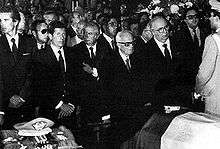
In Italy state funerals are granted[69] by law to the Presidents of the constitutional entities, such has the Presidency, the Parliament, the Government and the Constitutional Court, even after their terms have expired, and to Ministers who died during their term in office. State Funerals can also be granted, by decree of the Council of Ministers, to people who gave particular services to the country; to citizens that brought honor to the nation; or to citizens who died in the line of duty, or were victims of either terrorism, or organized crime.
The official protocol provides for[69]
- the coffin surrounded by six members in high uniform of either the Carabinieri or the same Armed Force the departed belonged to;
- an honor guard to the coffin at the entrance and the exit of the place in which the ceremony is held;
- the presence of one representative of the Government;
- an official commemorative oration;
- other honors that can be arranged by the Prime Minister.
For the funeral of the President or a former President the six members of the Carabinieri, who carry the coffin, belong to the special branch of the Corazzieri.
Public mourning, either national or local, is declared following the dispositions of the Prime Minister's decrees. The flags are flown at half-mast outside of public buildings, while inside they display two black ribbons, with the exceptions provided for military flags, when required by military protocol.[69] The Ministry of Foreign Affairs gives instructions to the Italian embassies and consulates around the world, and can ask the foreign embassies and consulates in Italy to fly their flags at half-mast.
If the departed held a public office, the body can lie in state in the building of the office's institution. In other cases it is followed the will of the family, the traditions of the office or the local customs.[69] The family of the departed chooses the place in which the funeral will take place, in consultations with the Government's Department of State Ceremonies.
Outside of the cases provided for by the protocol, for example during natural events that deeply impact the community, solemn funerals can be arranged[69] and the six people who carry the coffins are members of the Civil Protection.
Malta
State Funerals have been held for presidents, prime ministers and archbishops.
The last state funeral held for the President of Malta was that of Censu Tabone on March 2012.[70]
The last state funeral held for the Prime Minister of Malta was that of Dom Mintoff on August 2012.[71]
Netherlands
The royal funerals of Prince Claus, Queen Juliana and Prince Bernhard are the only royal funerals that were denoted state funerals; previous royal funerals were considered private affairs.[72][73] The only non-royal Dutchman who is considered to have received a state funeral was Joannes van Heutsz in 1927.[74]
Poland
Poland held a state funeral for President of Poland Lech Kaczyński and his wife, Maria Kaczyńska, on April 18, 2010 after he and 95 others perished in a plane crash.
Russia
In Russia, during the time of the Soviet Union (1917-1991), the state funerals of the most senior political and military leaders were staged as massive events with millions of mourners all over the USSR. The ceremonies held after the deaths as Vladimir Lenin, Joseph Stalin, Leonid Brezhnev, Yuri Andropov and Konstantin Chernenko all followed the same basic outline. They took place in Moscow, began with a public lying in state of the deceased in the House of the Unions and ended with an interment at the Red Square. The most notable examples of such state funerals during the Soviet period of Russian history are the ceremonies that were held for Lenin and Stalin, and for the death and funeral of Leonid Brezhnev.
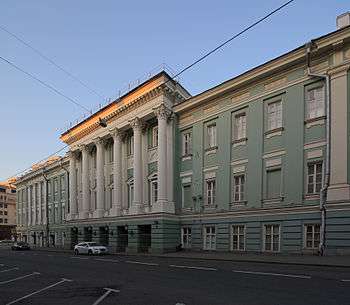
In the second half of the 20th century, whenever a General Secretary of the Communist Party of the Soviet Union died, the event would first be officially acknowledged by Soviet radio and television. After several days of national mourning, the deceased would be given a state funeral and then buried. Soviet state funerals were often attended by foreign heads of state, heads of government, foreign ministers and other dignitaries from abroad. Following the death of General Secretary Leonid Brezhnev in 1982, there were five days of national mourning. Following the death of General Secretary Yuri Andropov in 1984, a four-day period of nationwide mourning was announced.
The state funeral for a deceased General Secretary would be arranged, managed and prepared by a special committee of the Communist Party that would be formed for the occasion. As the funeral committee would normally be chaired by the deceased's successor, the preparations for Soviet state funerals were usually followed with great interest by foreign political scientists trying to gauge power shuffles within the Communist Party. The allocation of responsibilities during the funeral, appointment of pallbearers and positions within the order of precedence observed during the televised funeral ceremonies in Moscow could often be interpreted as a clue for the future position of Politburo members within the Party. When, after Brezhnev's death in 1982, Yuri Andropov was elected chairman of the committee in charge of Brezhnev's funeral, this was seen as a first sign by First World commentators that Andropov might be the most likely candidate for the position of General Secretary.[75]
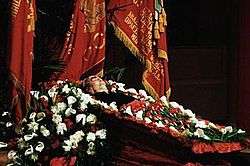
Prior to interment, the body of the deceased General Secretary would lie in state in the Pillar Hall of the House of the Unions which was decorated by numerous red flags and other communist symbols. The mourners, which usually would be brought in by the thousands, shuffled up a marble staircase beneath chandeliers draped in black gauze. On the stage at the left side of the Pillar Hall, amid a veritable garden of flowers, a full orchestra in black tailcoats would play classical music. The deceased's embalmed body, dressed in a black suit, white shirt and a tie, would be displayed in an open coffin on a catafalque banked with carnations, red roses and tulips, facing the long queue of mourners. A small guard of honour would be in attendance in the background. At the right side of the hall there would be placed seats for guests of honour, with the front row reserved for the dead leader's family.
On the day of the funeral, final ceremonies would be held at the Pillar Hall during which the lid of the coffin would be temporarily closed. The coffin would then be carried out of the House of the Unions and placed on a gun carriage drawn by a military vehicle. A funeral parade would then convey the coffin from the House of the Unions to the Red Square. Two officers led the funeral parade, carrying a large portrait of the deceased, followed by a group of numerous soldiers carrying red floral wreaths. A group of general officers would come next, carrying the late leader's decorations and medals on small red cushions. Behind them, the coffin rested atop a gun carriage. Walking immediately behind were the members of the deceased's family. The Politburo leaders, wearing red armbands, came next and led the last group of official mourners. At Brezhnev's funeral, the escort of official mourners included forty-four persons.
As the coffin reached the middle of the Red Square, it would be removed from the carriage and placed on a red-draped bier facing the Lenin Mausoleum, with its lid removed. After a series of funeral speeches, which were delivered by military and political leaders (typically including the deceased's successor as General Secretary, as well as 'ordinary' workers) from the balcony of the Lenin Mausoleum, the coffin would be carried in a procession around the mausoleum to the Kremlin Wall Necropolis just behind it. There, with the most senior mourners looking on, the coffin would be placed on a red-draped bier and the mourners would pay last respects. The coffin's lid would then be closed for the final time and the body lowered into the ground by two men, with handfuls of earth thrown onto the coffin by the senior mourners. The grave would be filled in immediately afterward, while the mourners were still present to watch. Gun salutes would be fired, sirens sounded around the Kremlin and the Soviet national anthem be played. This marked the end of the interment. The senior mourners would then return to the balcony of the Lenin Mausoleum to review a parade on Red Square while the military band would play quick marches. This concluded the state funeral.
With small deviations, the described protocol was roughly the same for the state funerals of Lenin, Stalin, Brezhnev, Yuri Andropov and Konstantin Chernenko. Lenin and Stalin were placed inside the Lenin Mausoleum while the others were interred in individual graves in the Kremlin Wall Necropolis located behind the mausoleum along the actual Kremlin wall. Stalin's body would lie beside Lenin's in the mausoleum until being moved to the Kremlin Wall Necropolis several years after his death.
In April 2007, Russian Federation's first President Boris Yeltsin was buried in state funeral after church ceremony at Novodevichy Cemetery. He was the first Russian leader and head of state in 113 years to be buried in a church ceremony, after Emperor Alexander III of Russia.
Slovakia
A state funeral was held for the former President Michal Kováč in 2016.
United Kingdom
A state or ceremonial funeral consists of a military procession where the coffin is borne on a gun carriage from the private resting chapel to Westminster Hall. In a state funeral the gun carriage is pulled by members of the Royal Navy. In a royal ceremonial funeral, the gun carriage is pulled by horses, as opposed to servicemen. The body usually lies in state in Westminster Hall for three days. This is then followed by a funeral service at Westminster Abbey or St. Paul's Cathedral. Many of the features of a state funeral are shared by other types of funerals—a royal ceremonial funeral (for example, that of Queen Elizabeth The Queen Mother and Diana, Princess of Wales) often has a lying in state and Westminster Abbey service. The real distinction between a state funeral and a royal ceremonial funeral is that a state funeral requires a motion or vote in Parliament. State funerals are usually reserved for sovereigns, though on rare occasions, they may be granted to distinguished citizens with exceptional contributions to the country. Other members of the royal family, or occasionally politicians, typically receive ceremonial funerals instead.
The most recent state funeral was that of Sir Winston Churchill in 1965. Although technically following her divorce from the Prince of Wales in 1996, Diana, Princess of Wales was no longer a member of the Royal Family, and as such not entitled to a state or ceremonial funeral, the large outpouring of public grief following her death led the Prime Minister Tony Blair to recommend a ceremonial funeral. Queen Elizabeth The Queen Mother and Baroness Margaret Thatcher also received ceremonial funerals.
Yugoslavia
A massive state funeral was held for the late President Josip Broz Tito on 8 May 1980 in Belgrade, the capital city of the SFR Yugoslavia. It was the largest funeral of a statesman in the 20th century, with 129 delegations from all around the world.Tito's funeral drew many statesmen to Belgrade. Notably absent statesmen from funeral were Jimmy Carter and Fidel Castro. His death came in the moment when Soviet invasion of Afghanistan ended American-Soviet détente. Yugoslavia, although a communist state, was non-aligned during the Cold War and fearful that the nation might be invaded like Czechoslovakia and Afghanistan. After learning that Chinese Premier Hua Guofeng would lead the delegation of China, ailing Leonid Brezhnev decided to lead the Soviet delegation. In order to avoid meeting with Leonid Brezhnev and the middle of electoral campaign for the 1980 United States Presidential election, Carter opted to send his mother Lilian Carter and Vice President Walter Mondale as heads of the US delegation. After realizing that leaders of all Warsaw Pact nations would attend the funeral, Carter's decision was criticized by Presidential candidate George H. W. Bush as sign that the United States "inferentially slams Yugoslavs at time that country has pulled away from Soviet Union".[10] Carter visited Yugoslavia later in June 1980 and made a visit to Tito's grave.[11][12]
Helmut Schmidt, Chancellor of West Germany was the most active statesman, meeting with Brezhnev, Erich Honecker and Edward Gierek. British Prime Minister Margaret Thatcher sought to rally world leaders in order to harshly condemn the Soviet invasion.[citation needed] While she was in Belgrade, she held talks with Kenneth Kaunda, Schmidt, Francesco Cossiga and Nicolae Ceaușescu. Brezhnev met with Kim Il-sung and Honecker. James Callaghan, President of the British Labour Party explained his presence in Belgrade as attempt to warm relations between his party and Yugoslav communists, severed more than a decade ago after dissident Milovan Đilas was welcomed by Jennie Lee, Minister for the Arts under Harold Wilson. Mondale avoided Soviets, ignoring Brezhnev while passing close to him. Soviet and Chinese delegations also avoided each other.[citation needed]
Tito was interred on May 8 twice. First interment was for cameras and dignitaries. Grave was shallow with only 200 kg replica of sarcophagus. Second interment was held privately during the night.[citation needed] His coffin was removed, shallow grave was deepened. Coffin was enclosed with copper mask and interred again into much deeper grave which was sealed with cement and topped with a 9-ton sarcophagus.[citation needed] Communist officials were afraid that someone might steal the corpse, similarly to what happened to Charlie Chaplin. However, the 9 ton sarcophagus had to be put in place with a crane, which would make funeral unattractive.
Macedonia
Since proclaiming independence in 1991,by law the presidents and prime ministers are entitled to a funeral with state honors, but by a decision of government its possible for other senior officials and distinguished persons with great merit for the state to be buried with state honors. The largest state funeral was held in 2004 for President Boris Trajkovski and the funeral was attended by 47 foreign delegations.Аmong others that are buried with state honors,are the first prime minister of independent Macedonia Nikola Kljusev and the famous singer Toše Proeski.
Gallery
-

A drawing depicting the funeral cortege of Richard II of England leaving Pontefract Castle, 1468.
-
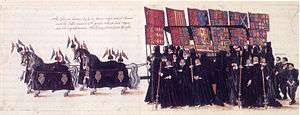
A drawing by William Camden depicting the funeral cortège of Queen Elizabeth I of England, 1603.
-
A drawing by Sebastián Muñoz depicting the lying in state of Queen Maria Luisa of Spain, 1689.
-

The coffin of Horatio Nelson in the crossing of Saint Paul's Cathedral during his state funeral, with the dome hung with captured French and Spanish flags, 1805.
-

The funeral train of Abraham Lincoln departing Washington D.C. en route to Springfield, Illinois for interment, 1865.
-

A drawing depicting Abraham Lincoln's funeral procession in New York City en route from Washington D.C. to Springfield, Illinois, 1865.
-
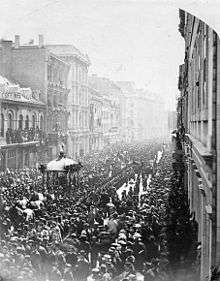
The funeral procession of Thomas D'Arcy McGee during his state funeral in Ottawa, Canada, 1868.
-
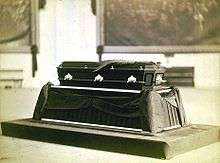
James A. Garfield's coffin lying in state on the Lincoln Catafalque in the United States Capitol Rotunda, 1881.
-
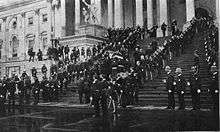
An honor guard carrying the coffin of William McKinley up the east steps of the United States Capitol, 1901.
-
The funeral procession of Edward VII of the United Kingdom in London, 1910.
-

The coffin of General Frederick Funston lying in state inside San Francisco City Hall in San Francisco, 1917.
-

The funeral procession of Liliuokalani in Honolulu, Hawaii, 1917.
-

A departure ceremony held on the center steps at the United States Capitol Building as honor guards carry the coffin of the Unknown Soldier of World War I to limbers and caissons, 1921.
-
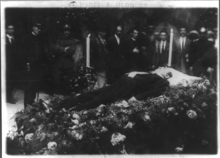
The lying in state of Italian tenor Enrico Caruso at the Church San Francisco de Paulo in Naples, 1921.
-

A limbers and caissons carrying the remains of Warren G. Harding at the North Portico entrance of the White House before its procession down Pennsylvania Avenue en route to the United States Capitol Building, 1923.
-

The funeral procession for Japanese Admiral Isoroku Yamamoto in Tokyo, 1943.
-
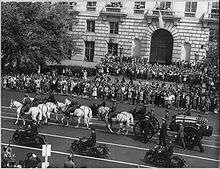
A caisson carrying the remains of Franklin D. Roosevelt proceeds down Pennsylvania Avenue towards the United States Capitol, 1945.
-
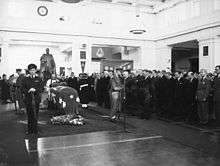
The coffin of Ben Chifley, the 16th Prime Minister of Australia, lying in state inside King's Hall, Old Parliament House, Canberra, 1951.
-

The funeral procession of former Argentinian First Lady Eva Peron, 1952.
-
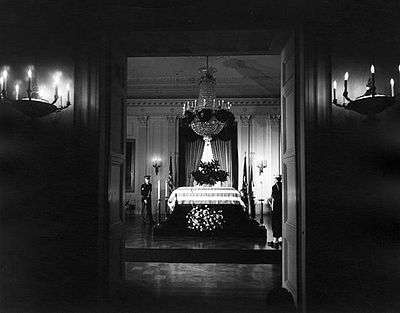
The remains of John F. Kennedy lying in repose in the East Room of the White House, 1963.
-
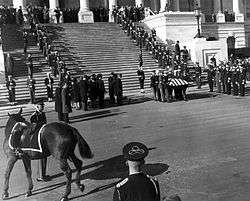
The caparisoned, riderless horse named "Black Jack" during a departure ceremony held at the United States Capitol Building in conjunction with the state funeral of John F. Kennedy, 1963.
-

Robert Kennedy and Ethel Kennedy seen following Jacqueline Kennedy as she leaves the United States Capitol with John F. Kennedy, Jr. and Caroline Kennedy, after viewing the lying in state of John F. Kennedy, 1963.
-

The remains of Dwight D. Eisenhower being carried down the center steps of the east front of the United States Capitol Building by honor guards, 1969.
-
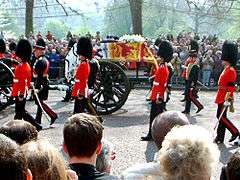
The funeral cortège of Queen Elizabeth The Queen Mother proceeds from the Palace of Westminster to Westminster Abbey, 2002.
-

A caisson carrying the remains of Ronald Reagan down Constitution Avenue en route to the United States Capitol, 2004.
-
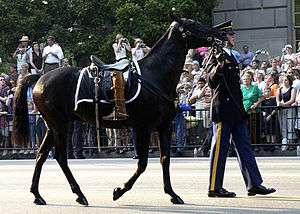
The caparisoned, riderless horse named Sergeant York during the ceremonial funeral procession of Ronald Reagan, with a ceremonial sword attached to the saddle and a pair of the president's boots reversed in the stirrups, 2004.
-
The body of Pope John Paul II lying in state at Saint Peter's Basilica, 2005.
-
The coffin of Gerald Ford lying in state in the rotunda of the United States Capitol during his state funeral, 2006.
-
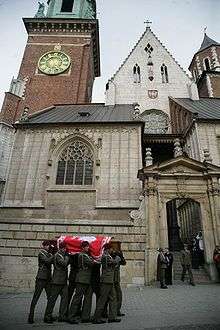
The coffin of President of Poland Lech Kaczyński is carried, 2010.
-

Argentine President Cristina Fernández passing by the coffin of her husband Nestor Kirchner.
-

Former Prime Minister of the United Kingdom Lady Margaret Thatcher's coffin being carried up the steps of St. Pauls Cathedral in the ceremonial funeral.
-

Margaret Thatchers coffin being carried on a gun carriage, and escorted by her pallbearers.
See also
- Abraham Lincoln's burial and exhumation
- "Black Jack"
- Burial at Sea
- Catafalque
- Death and funeral of Josip Broz Tito
- Death and funeral of Corazon Aquino
- Death and funeral of Leonid Brezhnev
- Death and funeral of Richard Nixon
- Death and state funeral of Gerald Ford
- Death and state funeral of King Hussein
- Death and state funeral of Lech Kaczyński and Maria Kaczyńska
- Death and state funeral of Néstor Kirchner
- Death and state funeral of Omar Bongo
- Death and state funeral of Pierre Trudeau
- Death and state funeral of Ronald Reagan
- Death and state funeral of Nelson Mandela
- Funeral of Diana, Princess of Wales
- Funeral of Edward VII
- Funeral of Pope John Paul II
- Funeral train
- Limbers and caissons
- Lincoln Catafalque
- Lying in repose
- Lying in state
- Military funeral
- Missing man formation
- Riderless horse
- State funeral of John F. Kennedy
- State funerals in Canada
- State funerals in the United States
- Vigil of the Princes
References
- ↑ Ortiz.
- ↑ "Murió el ex presidente Néstor Kirchner" [Former president Néstor Kirchner has died] (in Spanish). Buenos Aires: Clarín. 27 October 2010.
- ↑ Consternación por la muerte del ex presidente Néstor Kirchner (Spanish)
- ↑ "Cristina lo acompañó hasta el final, La Nación". Lanacion.com.ar. Retrieved 2010-10-28.
- ↑ "Argentine ex-leader Kirchner dies — Americas". Al Jazeera English. Retrieved 2010-10-28.
- ↑ "State funeral for David Thompson". BBC.
- ↑ "State Funeral for the Late Crispin A. Sorhaindo". Dominica Central Newspaper.
- ↑ "Rafael Correa autoriza a la Cancillería y a Defensa organizar funeral de Estado para Sixto Durán Ballén". El Comercio.com. November 16, 2016. Retrieved November 16, 2016.
- ↑ "Former Prime Minister to be accorded a State Funeral". Caribseek News.
- ↑ "Bob Marley's funeral program". Orthodoxhistory.org. Retrieved 4 June 2010.
- ↑ "30 Year Anniversary of Bob Marley's Death". Orthodoxhistory.org. Retrieved 11 May 2011.
- ↑ Moskowitz 2007, p. 116
- ↑ "State Funeral for Hugh Shearer on Sunday, July 18". Jamaica Information Service.
- ↑ Gaby Wood (May 17, 2012). "Presidents and Nobel winners honour Mexican writer Carlos Fuentes". The Telegraph. Retrieved May 17, 2012.
- ↑ "Sir Lynden Pindling State Funeral". Bahamas Conference of Seventh-day Adventists.
- ↑ "State Funeral announced for the late Sir Clifford Darling". The Bahamas Weekly.
- ↑ APPENDIX A-3-TABLE OF ENTITLEMENT, 1965. United States Army.
- ↑ "State Funeral Traditions". United States Army.
- ↑ "Arlington's Ceremonial Horses and Funerals at the White House" (PDF). White House Historical Association. Archived from the original (PDF) on 2010-06-26.
- 1 2 3 4 5 "Presidential Funerals". White House Historical Association.
- ↑ "President Lincoln's Funeral". The Lincoln Institute.
- ↑ "The funeral of Representative Thaddeus Stevens of Pennsylvania". United States House of Representatives.
- ↑ "Chapter 1: The Last Salute". United States Army.
- ↑ "Chapter 2: The Last Salute". United States Army.
- ↑ "Chapter 4: The Last Salute". United States Army.
- ↑ "Chapter 14: The Last Salute". United States Army.
- ↑ "Chapter 23: The Last Salute". United States Army.
- ↑ "Chapter 24: The Last Salute". United States Army.
- ↑ "Chapter 25: The Last Salute". United States Army.
- ↑ "Chapter 29: The Last Salute". United States Army.
- ↑ "Recent Mourning Observations at the White House". White House Historical Association.
- ↑ "LBJ's 1973 Funeral to Be Model For Farewell to 40th President". The Washington Post. 6 June 2004.
- ↑ "State Funeral and Tribute". The Gerald R. Ford Presidential Foundation.
- ↑ "State funeral : the late Sir Douglas Mawson". State Library of South Australia.
- ↑ "Whitlam family decline state funeral for Margaret". The Australian. 19 March 2012.
- ↑ "State Funerals". Protocol Queensland, Department of Premier and Cabinet.
- ↑ "Latest News".
- ↑ "State Funeral | Dig - The Burke & Wills Research Gateway". State Library of Victoria.
- ↑ http://www.scmp.com/node/573906
- ↑ http://www.apnewsarchive.com/1986/Throngs-attend-state-funeral-for-Gov-Edward-Youde/id-e54dccc7d8b13b9ae30b989f2cfdf170
- ↑ State funeral: CM went by people's sentiments
- ↑
- ↑ Michael Bassett, Sir Joseph Ward: A political biography Auckland University Press, 1993.
- 1 2 3 Barry Gustafson, From the Cradle to the Grave: A biography of Michael Joseph Savage, Reed Methuen, Auckland, 1986, p. 271.
- ↑ "Obituary, Death of the Premier", New Zealand Herald, Volume XXX, Issue 9204, 19 May 1893, Page 1. (Paper's Past Retrieved 1 December 2012)
- ↑ Trevett, Claire (January 12, 2008). "Govt breaks rules for a national hero". The New Zealand Herald. Retrieved 2008-01-15.
- ↑ "Nation's farewell to be broadcast". 2008-01-12. Retrieved 2008-01-14.
- ↑ Radio New Zealand News - Sir Edmund Hillary honoured by state funeral (12 January 2008) Archived February 12, 2012, at the Wayback Machine.
- ↑ Manatū Taonga Ministry of Culture and Heritage (29 September 2014). "Tomb of the Unknown Warrior". Retrieved 7 February 2015.
- ↑ "Lange wanted simple family funeral". The New Zealand Herald. August 15, 2005. Retrieved 2008-01-14.
- 1 2 3 4 5 6 "Traditions and Protocol of a Presidential Funeral". Official Gazette. Republic of the Philippines. 6 February 1964. Retrieved 11 July 2016.
- ↑ "Administration Order No. 89, s. 1964". Official Gazette. Republic of the Philippines. 6 February 1964. Retrieved 11 July 2016.
- 1 2 Villanueva, Marichu (December 16, 2003). "State funeral set for Ople". The Philippine Star. Retrieved July 11, 2016.
- ↑ Rimando, Lala (August 6, 2009). "Almost, but not quite, a state funeral for Cory". ABS-CBN News. Retrieved July 11, 2016.
- ↑ "Bulletin No. 6 from the Committee on Funeral Arrangements and Burial of the late Secretary Jesse M. Robredo". Official Gazette. Republic of the Philippines. 23 August 2012. Retrieved 11 July 2016.
- ↑ Fonbuena, Carmela (August 27, 2012). "What happens in a state funeral?". Rappler. Retrieved July 11, 2016.
- ↑ http://www.nationmultimedia.com/news/life/art_culture/30298053
- ↑ http://factsanddetails.com/southeast-asia/Thailand/sub5_8b/entry-3217.html
- ↑ http://www.buddhanet.net/bfuneral.htm
- ↑ http://iias.asia/iiasn/10/Regional/10CDIA12.html
- ↑ "Historie - Mindelunden Ryvangen" [History - Ryvangen Memorial Park] (in Danish). Ministry of Ecclesiastical Affairs. Retrieved 2015-05-31.
- ↑ Décret du 18 avril 2008 relatif aux obsèques nationales d'Aimé Césaire, JORF No. 93 du 19 avril 2008, p. 6562, texte No. 1, NOR HRUX0810057D, sur Légifrance.
- ↑ Loi No. 47-2293 du 6 décembre 1947 portant ouverture de crédits pour les funérailles nationales du général Leclerc, JORF No. 288 du 7 décembre 1947, pp. 11950–11951, sur Légifrance.
- ↑ Loi No. 49-338 du 14 mars 1949 portant que le général d'armée Giraud (Henri-Honoré), qui a commandé en chef devant l'ennemi, sera inhumé dans l'Hôtel national des Invalides et portant ouverture de crédits pour ses funérailles nationales, JORF No. 64 du 15 mars 1949, pp. 2643–2644, sur Légifrance.
- ↑ Loi No. 52-53 du 15 janvier 1952 portant ouverture de crédits pour les funérailles nationales du général de Lattre de Tassigny, JORF No. 13 du 16 janvier 1952, p. 659, sur Légifrance.
- ↑ Loi No. 50-1616 du 31 décembre 1950 portant ouverture de crédit pour les obsèques de M. Albert Lebrun, ancien Président de la République française, JORF No. 1 du 1er janvier 1951, p. 7, sur Légifrance.
- ↑ Loi No. 51-13 du 4 janvier 1951 portant ouverture de crédit pour les obsèques de M. Léon Blum, ancien président du conseil, JORF No. 5 du 5 janvier 1951, p. 228, sur Légifrance.
- ↑ Loi No. 57-390 du 28 mars 1957 relative aux obsèques nationales de M. Édouard Herriot, Président d'honneur de l'Assemblée nationale, JORF No. 75 du 29 mars 1957, p. 3267, sur Légifrance.
- 1 2 3 4 5 "Protocol for State Funerals and National Mourning". Official website of the Italian Government - Department of State Ceremonies.
- ↑ "Updated: The state funeral of President Censu Tabone". Maltastar. 16 March 2012. Retrieved 16 March 2012.
- ↑ "Updated: Mintoff state funeral, emotions as coffin is carried into St John's". Times of Malta. 25 August 2012. Retrieved 25 August 2012.
- ↑ http://www.koninklijkhuis.nl/onderwerpen/overlijden
- ↑ http://www.npogeschiedenis.nl/nieuws/2013/augustus/Prins-Johan-Friso.html
- ↑ http://www.parlementairdocumentatiecentrum.nl/id/vg09llzb6jzy
- ↑ White, Stephen (2000). Russia's new politics: the management of a postcommunist society. Cambridge University Press. p. 211. ISBN 978-0-521-58737-2.
Further reading
- Sandburg, Carl (1936). Abraham Lincoln: The War Years IV. Harcourt, Brace & World.
- Swanson, James (2006). Manhunt: The 12-Day Chase for Lincoln's Killer. Harper Collins. ISBN 978-0-06-051849-3.
External links
- Royal Windsor Website account, including truth about The Gun Carriage, the horses and the sailors.
- The traditions of a British state funeral
- Memorializing U.S. Presidents
- Funeral Section of the RCMP Ceremonial and Protocol Guide
- "STATE, OFFICIAL, AND SPECIAL MILITARY FUNERALS" by the U.S. Army
- The Last Salute (CMH Pub 90-1) published by the United States Army Center of Military History
- NSW Policy on State Funerals
- Commentary on state funeral offer for Australian Kerry Packer
- Royal Funeral of King Tafa'ahau Tupou IV - Royal Palace Office
- Royal Palace Office - Tonga